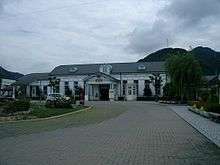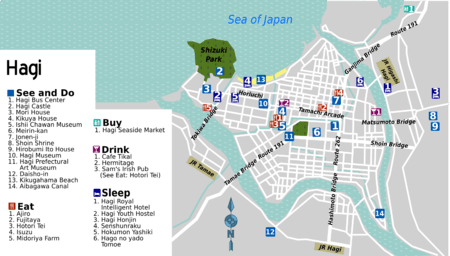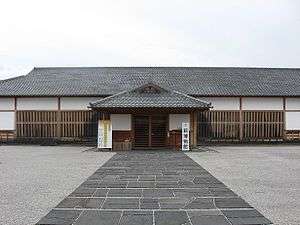Hagi
Hagi (萩市 Hagi-shi) is one of Japan's most beautiful castle towns, with many old streets and residences that have survived untouched to the present day.
Understand

The first castle in Hagi was built by the Yoshimi clan. But it was not until 1608 when the Mori clan, exiled here after a humiliating defeat by the Tokugawa shogunate, built their massive, imposing castle at the foot of Mt. Shizuki. The Mori clan transferred the capital of the Choshu Domain (Choshu-han) from Hiroshima to Hagi at the same time, where it remained the political center of the region for over 250 years.
In the middle of the 19th century, the Choshu allied with the Satsuma Domain to deliver some long-awaited payback, toppling the Tokugawa shogunate and thereby spurring the Meiji Restoration — and, with it, the modernizing of feudal Japan. Many Meiji statesmen were born and raised in Hagi, such as Hirobumi Ito, the first Japanese prime minister.
Tourist information
- 🌍 JR Hagi Station, ☎ +81 838-25-1750. Feb-Nov 9AM-5:45PM, Dec-Jan 9AM-5PM.
- 🌍 JR Higashi-Hagi Station, ☎ +81 838-25-3145. summer 9AM-5PM, autumn-spring 9AM-5PM. Left-luggage services are available. If you're staying overnight, they can arrange delivery to your hotel while you explore the city.
Get in
By plane
- 🌍 Hagi-Iwami Airport (IWJ IATA) (shuttle buses run from the airport near Masuda to the city (80 minutes)). One flight per day from Haneda (Tokyo) and Itami (Osaka) on ANA.
- 🌍 Yamaguchi Ube Airport (UBJ IATA) (from Ube, take a bus to Shin-Yamaguchi Station in Yamaguchi and connect via bus from there). The prefecture's largest airport, with regular flights to Haneda Airport in Tokyo on JAL and ANA (about 90 minutes).
By train

The closest Shinkansen station is Shin-Yamaguchi. Many Hikari and a few Nozomi trains stop there. The train link to Hagi from here is about 3 hours by limited express, but you can cut that in half by taking "Hagi-go" (はぎ号) bus to Hagi. It's run by Chugoku JR Bus.
If you want to take the train the full distance to Hagi, you'll want to take the Shinkansen to Asa station. Asa is only serviced by Kodama trains, and it is two stops from Shin-Yamaguchi and also two stops from Kokura, which is much more well serviced. From Asa take the Mine line to Nagatoshi (1 hour). Then take the San'in Line to Higashi-Hagi Station (half hour). You need to be careful to plan the connections well (both trains average about once every two hours), but if you do, this is about the same time as the bus from Shin-Yamaguchi.
If you like coastal scenery, you could also take the San'in line all the way from Shimonoseki, but this adds another hour.
The San'in Main Line runs around Hagi's main island. There are three stops in town: JR Higashi-Hagi Station (東萩駅), across the Matsumoto River to the east of the city center; JR Hagi Station (萩駅), a long walk to the south of the city center; and JR Tamae Station (玉江駅), a short walk south of the castle ruins and Mt. Shizuki.
When considering the train vs. bus question. You need to consider that local rural trains are not particularly comfortable nor do they have air conditioning, and for the bus, people that have trouble with motion sickness will have problems with the winding mountain highways, especially the way they are driven by these buses.
By bus
- 🌍 Hagi Bus Center (萩バスセンター), 11-2 Karahimachi (In the city center.), ☎ +81 838-22-3811. The city's main bus station. Buses run from Hiroshima (four hours), Umeda and Abeno-bashi in Osaka by Kintetsu (10 hours), and Shinagawa in Tokyo by Keikyu (14 hours).
Get around

The city center is on a delta between the Hashimoto River and the Matsumoto River. If you decide to walk, you're joining a long tradition — Hagi-Ōkan (萩往還), which connects Hagi and Yamaguchi City, was an important route during the Edo period, traveled frequently by merchants and samurai. It's now a popular trail for history-minded tourists.
By bus
The Hagi Junkan Maaru Bus (萩循環まぁーるバス) runs 7AM-7PM to almost all of the tourist sights. There are stops throughout town, but the two routes — blue and red — cross paths at a few points, including the Hagi Bus Center in the center of town. There are departures every half-hour or so. Rides of any length cost only ¥100, or ¥500 for a day pass.
The blue buses cover the north, west, and northwest parts of the city, including JR Tamae Station, the castle ruins, and the Horiuchi, Jokamachi, and Teramachi areas. The red buses cover the south and northeast, including JR Higashi-Hagi Station, Daisho-in, and sites further out such as Kasayama and the Reverberating Furnace.
By bicycle
Most of the major sights can be easily reached by bicycle. You can rent one at several places around town, such as JR Higashi-Hagi Station and Hagi Castle.
See
|
Choshu Five The Chōshū Five (長州五傑 Chōshū Goketsu) were members of the ruling class of the Chōshū-han. In 1863, they disguised themselves as English sailors and went to study in England at University College London, despite the policy of sakoku, which made leaving Japan illegal under penalty of death. Each went on to play a major role in the modernizing of Japan, and they remain heroes in Hagi today. |
Castle Town
Keep an eye out for "bent key" (kagimagari 鍵曲) paths while wandering through the castle town. These sharp right angles were designed to confuse enemies and make it easy for warriors who knew the terrain to corner them, so adjust your invasions accordingly.
- 🌍 Hagi Castle (萩城跡 Hagi-jō), ☎ +81 838-25-1826. 8AM-4:30PM, from 8:30AM Nov-Feb, to 6PM March. Hagi Castle served as the political center of the Choshu-han for over 250 years, only to be dismantled when the Choshu took the lead in modernizing Japan. (Castles are sooo feudal.) Stone walls, the moat, and gardens mark the remains of the castle today. Admission includes the Mori House, which is just south of the park. ¥210 adults, ¥100 children.
- 🌍 Shizuki Park (指月公園 Shizuki-kōen). Surrounding the castle ruins, this park is a popular spot for cherry blossom parties in the spring. Also here are a small shrine, a teahouse, the Jozangama pottery kiln (城山窯), and a hiking path leading up to the peak of Mt. Shizuki (about 140 meters).
The Horiuchi area (堀内), just southeast of Shizuki Park, was a residential section for wealthy merchants and the samurai elite. Many old houses, temples, and shrines remain in good condition, with virtually no modern structures among them. Just to the east of Horiuchi, the Jokamachi area also has several interesting old houses that are open to the public.
- 🌍 Kikuya House (菊屋家住宅 Kikuya-ke Jūtaku), 1-1 Gofuku, ☎ +81 838-25-8282. 9AM-5:30PM. The Kikuya merchant family lived in style, with a large house and a lovely garden. Today, their house is open to the public with over 5,000 period items on display, from dolls to a vintage phone booth. ¥500 adults, ¥300 students, ¥200 kids.
- 🌍 Ishii Chawan Museum (石井茶碗美術館 ishichawan bijutsukan), 33-3 Minamifuruhagi-machi, ☎ +81 838-22-1211. Tu-Su 9AM-noon, 1PM-4:45PM. A good place to check out hagi-yaki (see Buy), with a particular emphasis on tea bowls. ¥500.
- 🌍 Meirin-kan (明倫館), 3ku no 1 Emukai (Hagi Shiyakusho bus stop), ☎ +81 838-25-3139. Established by the Choshu-han, this school for gifted children used to be on the third floor of Hagi Castle, but moved to its own facilities in 1863. The school building is still in use as a part of elementary school. Visitors are free to tour the grounds, but not the interior.
Continuing east from Jokamachi, the Teramachi area features a cluster of old temples that were intended to double as barracks in case of enemy attack. Among the notables is Jonen-ji, whose carved front gate was transported from Kyoto by the Mori clan.
Shoin Shrine area
This area is a few minutes southeast of JR Higashi-Hagi Station, across the Matsumoto River from the city center.
- 🌍 Shōin Shrine (松蔭神社 shōin jinja), 1537 Matsumotoshi, Chinto, ☎ +81 838-22-4643. 8:30AM-5PM. A Meiji-era shrine dedicated to Yoshida Shōin, a young samurai who taught many of the students that went on to become major statesmen in Meiji Japan. Yoshida himself would not see it, though; chafing under the policy of sakoku, he tried to persuade Commodore Perry to smuggle him out of Japan, was imprisoned, and was later executed after plotting against the shogunate. Within the grounds of the shrine, his school Shoka-sonjuku (松下村塾) is preserved. There is also a hall dedicated to his life story (9AM-5PM, ¥650). Free.
- 🌍 Hirobumi Ito House (伊藤博文旧宅 hirobumi itō kyūtaku), ☎ +81 838-25-3139. 9AM-5PM. The former residence of Hirobumi Itō, the aforementioned first Prime Minister of Japan, and himself a former Shoin student. He served four terms as prime minister and drafted the Meiji constitution, but his involvement in Japan's annexation of Korea is a blot on his legacy. Free.
- 🌍 Tōkō-ji (東光寺). 8:30AM-5PM. This is the family shrine of the Mori clan. The beautiful gate, belfry, and temple buildings show Chinese influence; behind the temple are the graves of several Mori warlords — and 500 stone lanterns to mark their power. It's a short walk east of Shoin Shrine. ¥300.
Hiyako area
In the southwestern part of the city is the Hiyako area (平安古), which features a few museums of interest and more old houses that are open to tourists, such as that of Giichi Tanaka, another former Prime Minister.

- 🌍 Hagi Museum (萩博物館), 335 Horiuchi, ☎ +81 838-25-6447. 9AM-5PM. Built in 2004, this museum has exhibitions about samurai Yoshida Shoin and Takasugi Shinsaku. ¥500 adults, ¥300 students, ¥100 children.
- 🌍 Hagi Prefectural Art Museum (山口県立萩美術館・浦上記念館), 586-1 Hiyako. 9AM-5PM. Features displays of Asian pottery and Japanese ukiyo-e (wood-block prints). Admission varies by exhibit.
Others
- 🌍 Aibagawa Canal (藍場川) (In the southeast corner of the city.). It was built for transportation of goods, and also to supply water for extinguishing fires. Today, the path along the canal makes for a nice stroll.
- 🌍 Daishō-in (大照院). 8:30AM-5PM. The Mori warlords who aren't at Toko-ji are buried here — along with the graves of several retainers, who committed seppuku upon the death of their masters. The atmosphere at Daisho-in is strikingly calm, though, compared to the pomp of Tokoji. ¥300.
- 🌍 Kasayama (笠山) (accessible from JR Koshigahama Station, which precedes Highashi-Hagi on the San'in Line). It is the smallest active volcano in East Asia, and offers panoramic views of the Sea of Japan. Look for the lovely camellia flowers during February and March.
- 🌍 Myōjin Pond (明神池). A small pond at the foot of the mountain, which houses saltwater fish.
- 🌍 Reverberating Furnace (萩反射炉 Hansharo), Chinto 4897-7 (Northeast of the city center). This massive furnace was built in 1858 for the production of modern weapons, but rarely used. It's partially in ruins today, but still an impressive sight. Free.
Do
Amidst all of the old samurai atmosphere, don't forget that Hagi is on the Sea of Japan — there's swimming to be done. Try Kikugahama, a popular beach to the east of Mt. Shizuki and north of the city center.
- 🌍 Boat Cruise (萩八景遊覧船), ☎ +81 838-25-1750. 9AM-4PM March-Oct, to 3PM Nov. The Hagi Tourist Association runs pleasant cruises on the Hashimoto River and the Sea of Japan, with a guide to direct attention to the Eight Fine Views. ¥1200 adults, ¥600 kids.
- Kurumayado Tenjuppei (俥宿 天十平), ☎ +81 838-26-6474. 9AM-5PM. Rickshaw tours of the historic sections of the city center. They have standard itineraries to match the tour length, but substitutions can be made. For two people, expect to pay ¥6000 for 30 minutes, ¥10,000 for one hour, or ¥20,000 two hours..
- 🌍 Yuzuya Honten (柚子屋本店), 1189 Chinto, ☎ +81 838-25-7511. 9AM-5:30PM. The natsumikan is a citrus fruit that's grown in many local gardens, and squeezed into a tasty juice. At Yuzuya Honten, you can buy natsumikan and other local fruits whole, enjoy them as ice cream, or lend a hand at turning them into juice or marmalade. Visitors also get a free cup of Sonjoku (村塾), a local beer. It's on a peninsula directly north of the city — either take a cab or walk west from JR Koshigahama Station.
Festivals
- Hagi-yaki Festival (萩焼まつり). This festival is at the beginning of May. About 50 pottery shops from around the city come to the City Gymnasium to exhibit and sell their wares. It's a great opportunity to buy hagi-yaki at a low price.
- Hagi Summer Festival (萩夏まつり). This festival at the beginning of August. On the first day, about 8,000 fireworks are lit over the sea off Kikugahama.
- Hagi Historical Festival (萩時代まつり). During weekends in November, this festival involves people in traditional Choshu garb on parade through the center of town.
Buy

A handful of souvenir shops can be found near the castle.
- Hagi-yaki (萩焼). It is the local form of Japanese pottery and the top souvenir from a trip to Hagi. It is unique because of the way it reacts to water; over time, you'll notice delicate changes in its color. A few pottery shops offer visitors the chance to cast their own hagi-yaki — check with a tourist information office to see what is available.
- 🌍 Tamachi Arcade (田町商店街 Tamachi shōtengai). It runs through the center of town with an array of small shops, modern and traditional.
- 🌍 Hagi Seaside Market (萩しーまーと Hagi shīmāto). 9:30AM-6PM. A complex of shops and restaurants that sell fresh seafood and hagi-yaki.
- 🌍 Joyful Center Susa (ジョイフルセンター須佐), 7248-10 Susa, ☎ +81 083-876-2215. Souvenir shop that offers fresh and special seafood.
Eat

Kenran Beef (見蘭牛) is a local specialty. It has a fatty, marbled texture and tenderness. Most hotels will have it on their dinner menu. Hagi is also a great place for fresh seafood, particularly sea urchin and squid.
- 🌍 Ajiro (あじろ), ☎ +81 838-22-0010. Th-Tu 11:30AM-2PM, 5PM-9PM. Kaiseki sets of the best of the local seafood catch. ¥2300-¥6100.
- 🌍 Fujitaya (ふじたやそば店), 59 Kumagaya-cho, ☎ +81 838-22-1086. 11AM-7PM. A local institution — though a bit tricky to find — Fujitaya serves hot tempura and other dishes, but the specialty is seiro-soba, in which tasty soba noodles are delivered to your table in a steaming basket. ¥700.
- 🌍 Hotori Tei (庭園カフェ 畔亭), 62 Minami Katakawa, ☎ +81 838-22-1755. 11AM-5PM. Lunch sets in a lovely garden setting, in Jokamachi. Later in the evening, the same folks run Sam's Irish Pub (see Drink). ¥1600.
- 🌍 Isuzu (季節料理 いすず), 8-1 Imafuruhagi-machi, ☎ +81 838-22-5196. 11AM-3PM, 5PM-11PM. Sea urchin and other tasty sea critters.
- 🌍 Midoriya Farm (みどりや), 89 Horiuchi, ☎ +81 838-26-0141. Tu-Su 5PM-10PM, lunch by reservation 11:30AM-2PM. The famed Kenran Beef is grilled here; if you enjoy it, gift boxes are available to take home. Seafood is served as well. Sets from ¥2100-¥5250.
- 🌍 Tangotei (丹吾亭), 1232-1 Shimotama (In the former town of Tamagawa, recently merged into Hagi (now northeast of the city center) near JR Esaki Station.), ☎ +81 838-72-0264. W-M 11AM-2PM, 5PM-8PM. Delicious, freshly caught seafood, including knockout sashimi. Sets from ¥1380, or a feast for ¥5800.
Drink
Chonmage beer (チョンマゲビール) is a local brew. Hagi also has a few traditional sake factories, with bottles available at souvenir shops.
- 🌍 Café Tikal (長屋門珈琲 カフェ・ティカル), 298-1 Tsutihara (Near the gate of the Ogawa family residence.), ☎ +81 838-26-2933. Tu-Sa 9:30AM-8PM, Su 9:30AM-6PM. A traditional café with specialty coffee.
- 🌍 Hermitage (惺々庵), 1-27 Gofuku, ☎ +81 838-22-3929. 9AM-5PM. A café with a beautiful Japanese garden, right by the Kikuya House. They have a selection of hagi-yaki on display.
Sleep
If you're planning to splurge on a traditional Japanese inn, Hagi is a great place to do it; the art of the ryokan is taken seriously here, and the atmospheric old quarters are well worth an early morning or late evening stroll. The local ryokan association has a booking desk at the Hagi Bus Center (9AM-5:30PM, tel. +81 838-22-7599).
Budget
- 🌍 Hagi Royal Intelligent Hotel (萩ロイヤルインテリジェントホテル), 3000-5 Chinto, ☎ +81 838-21-4589. A good business hotel. Amenities include Internet access and a breakfast of rice balls & miso soup. Rooms have private baths, but there's a small public bath available. Singles ¥5400, doubles ¥7400.
- 🌍 Hagi Youth Hostel (萩ユースホステル), 109-22 Horiuchi (Near JR Tamae Station.), ☎ +81 838-22-0733. Check-in: 4PM-10PM, check-out: 6AM-10AM. Excellent location near the castle ruins. Bicycle rentals available. ¥2940 per night; breakfast ¥525, dinner ¥945.
- 🌍 Susa Bay Ecology Campsite (須佐湾エコロジーキャンプ場), 787 Susa, ☎ +81 83-876-2727.
Mid-range
- 🌍 Hagi Honjin (萩本陣), 385-8 Chinto, ☎ +81 838-22-5252. Western and Japanese-style rooms in a hotel eight stories tall, with a rooftop lounge and some very nice public baths. Rooms from ¥12,600.
- 🌍 Senshunraku (萩焼の宿 千春楽), 467-2 Horiuchi, ☎ +81 838-22-0326. A hot spring inn with easy access to the beach at Kikugahama. The rooms aren't quite sparkling, but the armored samurai mannequins guarding the lobby ought to keep away any troublemakers. Rooms from ¥11,500.
Splurge
- 🌍 Hokumon Yashiki (北門屋敷), 210 Horiuchi, ☎ +81 838-22-7521. Elegant Japanese-style rooms with a beautiful garden and outdoor baths. Good seafood dinners as well. Rooms ¥20,000-68,000, including two meals.
- 🌍 Hagi no yado Tomoe (萩の宿・常茂恵), 608-53 Hijiwara-Koboji, ☎ +81 838-22-0150. The height of luxury in Hagi — this is a gorgeous ryokan with a raked-stone garden, onsen, free pick-up from the train station, and more. Rooms ¥20,000-70,000, including dinner and breakfast.
Go next
Other cities in and around Yamaguchi prefecture include:
- Yamaguchi - the capital city in medieval times
- Tsuwano - castle town with impressive red roofs
- Nagato
- Akiyoshidai
- Masuda
- Hamada
- Shimonoseki - at the tip of Honshu
- Ube
- Iwakuni - a city with a beautiful wooden bridge
| Routes through Hagi |
| W |
→ Masuda → Matsue |